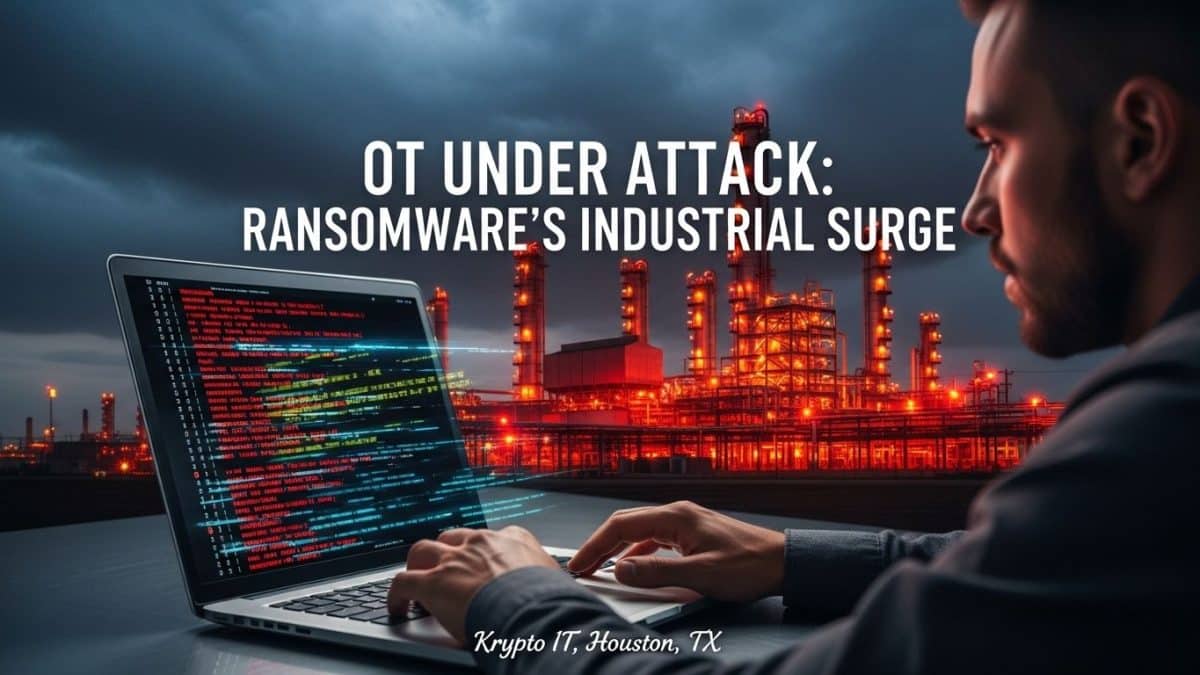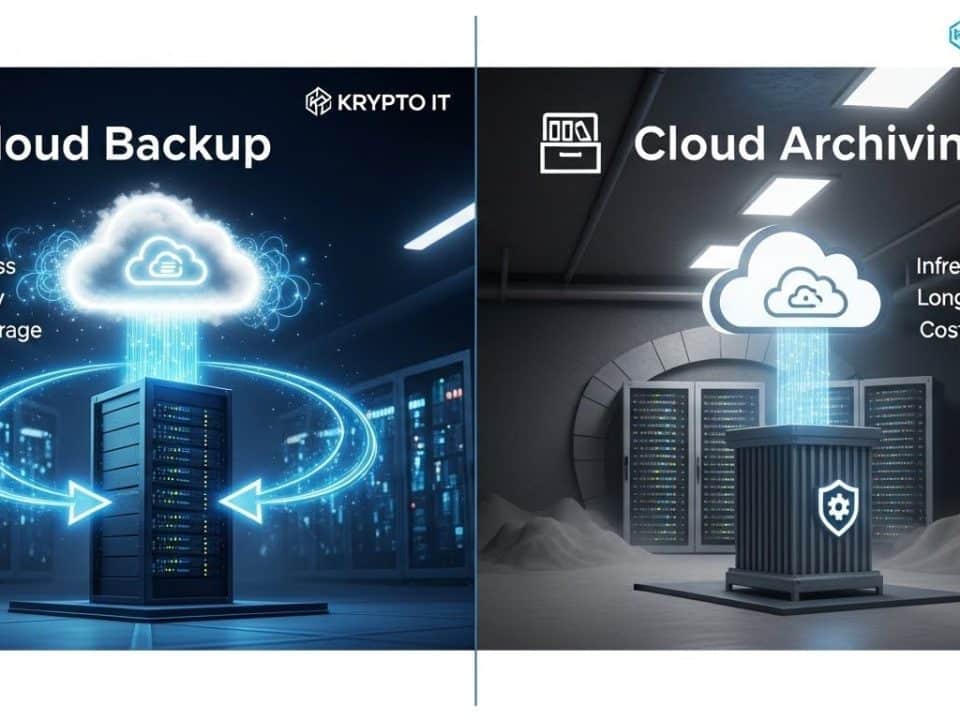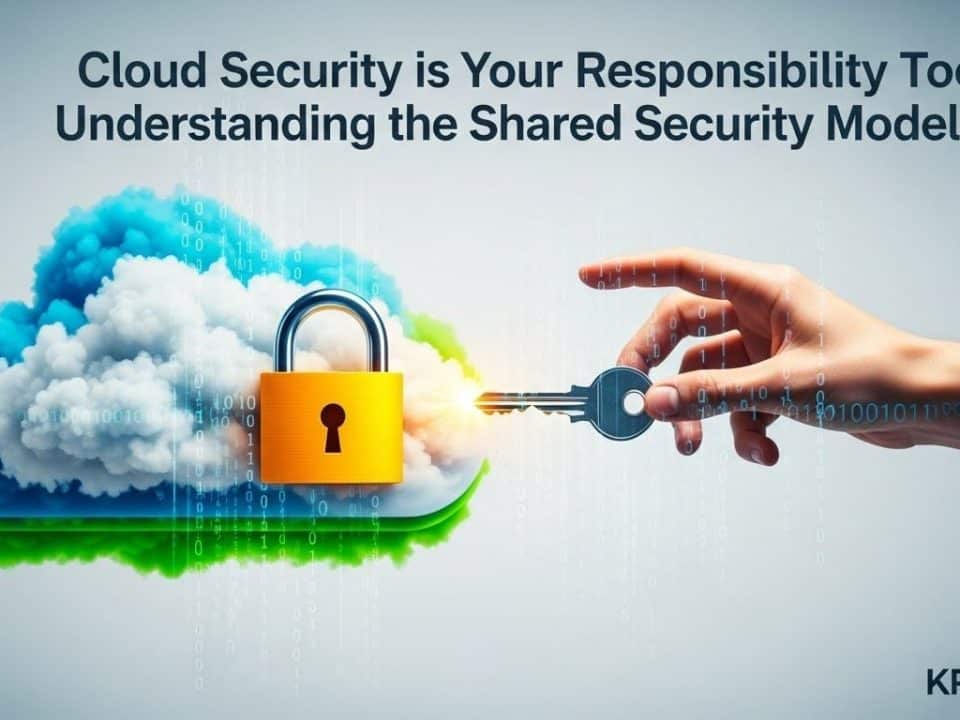
Ongoing Breaches: The Credential Crisis
June 19, 2025
16 Billion Passwords Exposed: A Global Crisis
June 22, 2025Protecting Houston’s Manufacturing & Critical Infrastructure from a Growing Threat
Recent cybersecurity reports paint a concerning picture for industrial sectors: a significant and accelerating surge in ransomware attacks specifically targeting Operational Technology (OT) systems. With a reported 46% increase in Q1 2025, this alarming trend poses a critical threat to businesses in Houston and beyond that rely on industrial control systems (ICS), building management systems (BMS), and other OT infrastructure. Unlike attacks focused solely on IT networks, ransomware targeting OT can have far more severe consequences, impacting not just data but also physical processes, safety, and even human lives.
For SMBs in Houston’s thriving industrial and manufacturing landscape, understanding this evolving threat and implementing robust OT cybersecurity measures is no longer a luxury – it’s a fundamental necessity for business continuity and safety.
Why the Focus on OT? A Perfect Storm for Attackers
Several factors contribute to the increasing targeting of OT systems by ransomware gangs:
- Critical Infrastructure Dependence: OT systems control essential services and industrial processes. Disrupting these operations can have widespread and significant consequences, making victims more likely to pay a ransom to quickly restore functionality.
- Legacy and Vulnerable Systems: Many OT environments rely on older, often unpatched or difficult-to-patch systems that were not designed with modern cybersecurity in mind. These legacy systems present a prime target for attackers exploiting known vulnerabilities.
- IT/OT Convergence: The increasing integration of IT and OT networks, while offering operational benefits, has also blurred the security boundaries. A successful ransomware attack on an IT network can now more easily spread to interconnected OT systems if proper segmentation and controls are lacking.
- High Stakes, High Reward: The potential for significant financial losses and operational downtime in industrial settings makes OT targets lucrative for ransomware operators. The pressure to resume production quickly often outweighs the risks of paying a ransom.
- Lack of Specialized Security: Historically, OT security has lagged behind IT security. Many industrial organizations lack dedicated OT security expertise, specialized monitoring tools, and robust incident response plans tailored to these unique environments.
- Unique Protocols and Challenges: OT systems utilize proprietary protocols and have stringent uptime requirements, making traditional IT security solutions and patching strategies difficult to implement without potentially disrupting operations.
The Anatomy of an OT Ransomware Attack
While the initial access vector might vary (e.g., phishing an employee with access to the OT network, exploiting a vulnerability in a human-machine interface (HMI) exposed to the internet, or leveraging a compromised IT system), the progression of an OT ransomware attack often involves:
- Initial Intrusion: Gaining a foothold in either the IT or OT network. This could be through social engineering, exploiting software vulnerabilities, or compromising remote access points.
- Lateral Movement: Once inside, attackers attempt to move laterally across the network, identifying and gaining access to critical OT components like PLCs, SCADA servers, and HMIs.
- Privilege Escalation: Elevating their access privileges to gain control over OT systems and disable security controls.
- Ransomware Deployment: Deploying ransomware specifically designed to target OT systems. This malware may encrypt data on HMIs and engineering workstations, or, in more sophisticated attacks, even disrupt control logic within PLCs, leading to physical process disruptions.
- Extortion: Demanding a ransom payment (typically in cryptocurrency) in exchange for decryption keys and potentially a promise not to leak any exfiltrated data (if data theft occurred).
The Dire Consequences for Houston’s Industrial Sector
A successful ransomware attack on an OT system in Houston’s industrial sector could have severe repercussions:
- Production Halts and Economic Losses: Manufacturing facilities could be forced to shut down, leading to significant financial losses due to missed production targets, contractual penalties, and idle workforce.
- Safety Incidents: Manipulation of control systems could lead to equipment malfunctions, safety hazards for workers, and even environmental disasters.
- Damage to Critical Infrastructure: Attacks on energy, water treatment, or transportation systems could have widespread consequences for the entire Houston community.
- Reputational Damage and Loss of Trust: A publicized attack could severely damage a company’s reputation and erode customer trust.
- Supply Chain Disruptions: Disruptions to key industrial players in Houston could have cascading effects throughout regional and national supply chains.
Fortifying Houston’s Industrial Businesses Against OT Ransomware
Protecting OT systems requires a focused and layered security approach:
- Strict Network Segmentation: Implement robust network segmentation to isolate OT networks from IT networks. Employ firewalls with deep packet inspection and intrusion detection/prevention systems to control traffic flow between these environments.
- Enhanced Endpoint Security for OT: Deploy specialized endpoint security solutions designed for OT environments. These solutions should be capable of detecting and preventing malware without disrupting real-time control processes.
- Strong Authentication and Access Controls: Enforce strong, unique passwords and multi-factor authentication (MFA) for all access to OT systems. Implement granular role-based access control to limit user privileges to only what is strictly necessary.
- Continuous Monitoring and Anomaly Detection: Implement specialized OT security monitoring tools that can analyze network traffic and system behavior for anomalies that might indicate a cyberattack. Establish security operations center (SOC) capabilities with OT-specific expertise.
- Secure Remote Access Solutions: Minimize remote access to OT systems. When necessary, utilize secure VPNs with strong authentication and strict access controls. Consider using one-way communication diodes to prevent bidirectional traffic from untrusted networks.
- Regular Vulnerability Assessments and Patch Management (with Caution): Conduct regular vulnerability assessments specifically tailored to OT environments. Develop a well-defined patch management process that includes thorough testing in non-production environments before applying patches to critical OT systems.
- Robust Backup and Recovery for OT: Implement a comprehensive backup and recovery plan specifically for OT systems. Ensure backups are isolated and regularly tested for restorability.
- Incident Response Planning Tailored for OT: Develop an incident response plan that addresses the unique challenges of OT environments, including safety protocols, coordination with operational teams, and procedures for containing and recovering from an attack without causing physical harm.
- Employee Training and Awareness for OT: Conduct specialized cybersecurity awareness training for OT personnel, highlighting the specific threats targeting industrial control systems and the importance of following security protocols. Foster a culture of security within the OT environment.
- Collaboration and Information Sharing: Encourage collaboration and information sharing within the industrial sector regarding emerging threats and best practices for OT security. Participate in industry-specific security forums and information sharing and analysis centers (ISACs).
The surge in ransomware attacks targeting OT systems represents a significant and evolving threat to Houston’s vital industrial sector. Proactive and dedicated cybersecurity measures are essential to protect these critical operations from disruption, ensure safety, and maintain economic stability. Krypto IT is committed to helping industrial businesses in Houston understand and mitigate these unique risks, providing specialized expertise and solutions for securing your operational technology environments.
Contact us today to schedule a free consultation and discuss how we can help you fortify your OT systems against the growing threat of ransomware.




